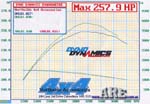 This
is 193kw @ rear
36" tyres! Wow ! This
is 193kw @ rear
36" tyres! Wow !
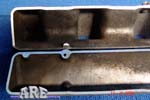


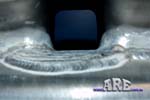

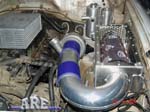

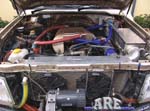

 |
This dyno graph is from the May
Labour Day competition @ the 3 day Landcruiser Park
bash. If this hasn't caught
your attention, then you must be a petrol head with
no knowledge of diesel engines. To put it into
perspective, with the same big chunky 36" tyres &
the same diff., he has gone from 75.3kw. with the
top mount air-air, to 81.0kw ( 7.6%increase) with
our air-water, to 193kw (138%increase) with our
prototype air-water intercooler-plennum unit !!!
Obviously, there is allot more than our intercooler
involved here. He went to a tubular exhaust, ball
bearing Garrett turbo, tidied inlet ports & a very
special big $$$ fuel pump. All the work was
performed by Heath & Ian with product from
businesses in south east Qld.
These three pics are what I used
to convince the guys to go with an untried idea I've
had for years, & spend much more than they wanted
too. I had shown them the six pages of our computer
modelling programme with a few different scenarios,
& they knew that was very accurate from past
experience, BUT, there was two stumbling blocks. The
plennum was untried & I'm not that big into diesels
so didn't give any guarantees, & Ian said that he
could do a Chev V8 conversion for similar money -
valid. Heath pointed out that while a V8 could have
more power, it would never have the low end Grunt &
engine breaking of these diesels. I'd given them a
bloody good price as they were the 'guinea pigs',&
it would be two at the same time, so it was crunch
time. I clearly remember the guys talking it over
out at their car for over an hour, before coming in
& laying a deposit down.
The carbon build up is a give away to the poor
factory design when the boost is raised. The blacker
the area, the slower the air speed &/or turbulence,
meaning those cylinders are not getting the same
amount of air. Three & four are clearly the lean
cylinders & will burn the pistons up early (or at
least dramatically shorten head gasket - valve -
ring life at best) at the tune levels these guys
wanted to go to. We also considered welding the
single entrie & making two entries into the oe log,
which would've been heaps cheaper, but I bet they're
bloody glad we didn't take that shortcut.
It's not the sort of job you get a
mate to do for a couple cartons. There's my thirty
years of air flow bench & 20 years of TIG welding
experience in this. I had to pad weld this part of
the inlet to get a very smooth transition with the
best transition angles. In fact, I picked up a
little flow on the second plennum, so cut the first
one off & did the same mod to it, at no charge. Not
many shops are that conciencious - or maybe I'm a
dickhead?
This is tricky welding, 3mm plate
butted onto 4mm plate of cladded alloy, 4 mm from
0.03mm fins & it has to be a full penetration
weld as it has the full weight of the cooling matrix
hanging off it.
Trial fit up during fabrication to
make sure everything lined up. The engine is
swallowing over 900 cfm now, & with the chunky tyres
throwing rocks, dirt & dust everywhere, filtering is
paramount. I just can't stress this enough. That's
why we fitted such a big K&N pod filter & our own
easily replaceable foam pre filter that slides in
the mesh near the entry.In a sense the inlet track
is 20mm long as that's the total of length between
the turbo outlet & tank inlet. How much lag?
Compared to a front mount it's almost unmeasurable.
Even though our plennum is 478% larger than oe., lag
is heaps less than a front mount instal
850rpm,
2500rpm,
4500rpm
- front mount & pipeing -
0.691 sec
0.235sec
0.131sec
- our air water/plennum assy.-
0.499 sec 0.169
sec
0.094sec
the above figures are from are computer modelling
Lag programme. They are how long it takes a molecule
of charge air to travel from the compressor housing
outlet to the valve head, at the rev. stated & if
the pipes are straight. There are far too many
variables to be able to calculate accelerating lag
as you can see it is exponentially quicker as revs
rise.
This is the end result on Heaths
truck. He kept the same radiator( which will
struggle on a long straight on a hot day), & of
course, the Davies Craig EWP will handle the flow
easily.
Apart from cost, the only other problem could be
longetivity, with so much weight swinging off the
top of a vibrating engine & then being pounded be
such rough use these guys throw their trucks at! We
have done everything possible with both materials
used & fabrication skill & tricks for the longest
life possible. The air speed in the short 63mm pipe
connecting the compressor housing to the the ic.
inlet tank is 254kph! We're now pulling 63kw (3583
BTU/m)of heat out of the intake charge, allowing
their other engine mods. to achieve the impressive
power output. They're good turbo petrol engine
specifications, but then I'd love to see this engine
in a 1400 kg VL Commodore beside allot of imports at
the lights! It would have similar power to a HSV 300
kw Monaro, less weight, & don't even think of how
much more torque !! What a burn out weapon - mega
grunt at any revs.
The air speed in the 4" snorkel is
92kph! so you can see why I talked them into such an
elaborate air box - it's necessary at this level
believe me. |